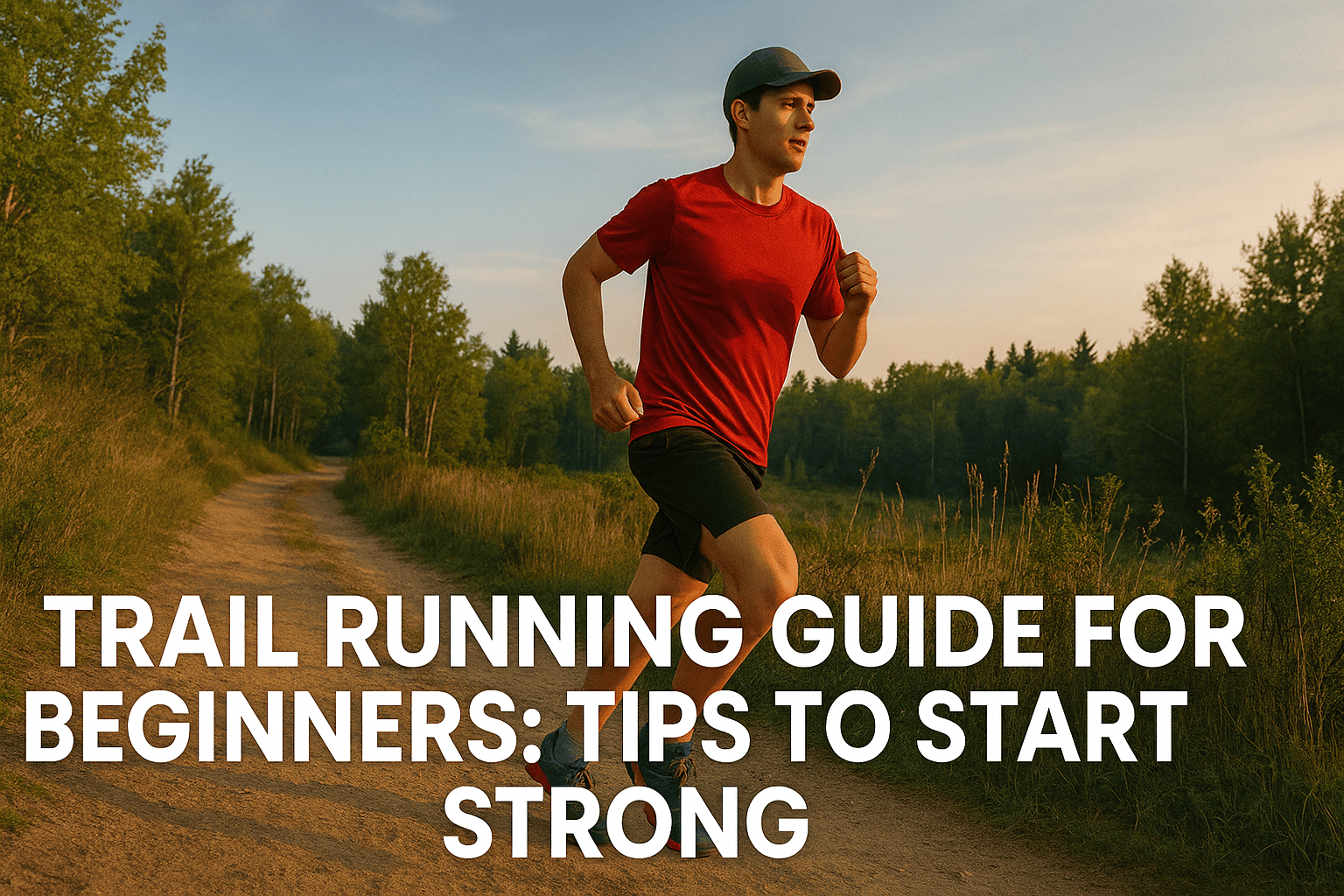Trail Running Guide for Beginners: Tips to Start Strong

Trail running is an exhilarating way to combine fitness with the beauty of nature. Unlike road running, trail running offers diverse terrains, scenic views, and the challenge of navigating through various natural obstacles. Whether you’re looking to improve your fitness, enjoy the great outdoors, or prepare for a trail running event, this guide will help you get started.
Table of Contents
Introduction
Trail running is a sport that blends the rigors of running with the natural beauty and challenges of outdoor trails. For beginners, it offers an exciting way to engage with nature while improving physical fitness. Unlike the monotony of running on paved roads, trails provide a dynamic environment that keeps runners engaged and motivated.
Benefits of Trail Running
Trail running offers numerous benefits that go beyond physical fitness:
- Improved Cardiovascular Health: Running, in general, is excellent for cardiovascular fitness. The varied terrain in trail running adds an extra layer of cardiovascular challenge.
- Enhanced Strength and Agility: Navigating trails requires more effort than flat surfaces, helping to build leg strength and improve balance and agility.
- Mental Health Benefits: Being in nature has proven psychological benefits, reducing stress and improving mood.
- Weight Management: The combination of aerobic and strength exercise helps in maintaining a healthy weight.
- Community and Camaraderie: Many trail runners enjoy the social aspect, whether it’s joining a local running group or participating in trail running events.
Getting Started
Choosing the Right Gear
Having the right gear can make your trail running experience much more enjoyable and safe. Here’s what you need:
- Trail Running Shoes: Unlike road running shoes, trail shoes provide better grip, stability, and protection against rocks and roots. Look for shoes with a rugged outsole and good ankle support.
- Clothing: Wear moisture-wicking, breathable clothing. Layering is crucial, especially in varying weather conditions.
- Hydration Pack: For longer runs, a hydration pack or handheld water bottle is essential to stay hydrated.
- Safety Gear: Consider carrying a whistle, a small first aid kit, and a trail map or GPS device.
- Accessories: Sunglasses, a hat, and sunscreen can protect you from the elements.
Finding Trails
Finding the right trails is key to a great trail running experience. Here’s how to locate them:
- Local Parks and Nature Reserves: Start with local parks, which often have well-maintained trails suitable for beginners.
- Trail Running Apps and Websites: Use apps like AllTrails or websites dedicated to trail running to discover new trails.
- Running Clubs and Groups: Join local trail running groups or clubs. Experienced runners can provide valuable trail recommendations.
- National and State Parks: These often have extensive trail systems that cater to all levels of runners.
Training and Techniques
Building Endurance
Endurance is crucial for trail running, as trails are typically more demanding than roads. Here’s how to build it:
- Start Slow: Begin with shorter runs and gradually increase your distance. Listen to your body and avoid pushing too hard too soon.
- Interval Training: Incorporate interval training into your routine. Alternate between running and walking to build stamina.
- Cross-Training: Engage in other forms of cardio, such as cycling or swimming, to boost overall fitness without overloading your joints.
- Consistent Training: Aim to run regularly, at least three times a week, to build and maintain endurance.
Improving Technique
Good technique can make trail running more efficient and reduce the risk of injury:
- Shorter Stride: Take shorter, quicker steps to maintain balance on uneven terrain.
- Focus on Foot Placement: Pay attention to where your feet land to avoid obstacles and maintain stability.
- Uphill Running: Lean slightly forward, use your arms for balance, and take shorter steps.
- Downhill Running: Stay upright or lean slightly back, keep your knees slightly bent, and use a controlled pace to avoid falls.
- Strength Training: Incorporate exercises that strengthen your core, legs, and ankles to improve overall stability and power.
Safety Tips
Safety should always be a priority when trail running:
- Run with a Partner: If possible, run with a friend or let someone know your route and estimated return time.
- Check the Weather: Always check the weather forecast before heading out. Avoid trails in adverse conditions like heavy rain or extreme heat.
- Know the Trail: Familiarize yourself with the trail, including its difficulty level and any potential hazards.
- Stay on Marked Trails: Stick to designated trails to avoid getting lost and to protect the environment.
- Carry Essentials: Bring a map, a fully charged phone, and some form of identification. A small first aid kit can also be useful.
Nutrition and Hydration
Proper nutrition and hydration are key to maintaining energy levels and performance:
- Pre-Run Meal: Eat a balanced meal 2-3 hours before your run. Include carbs for energy and a moderate amount of protein.
- During the Run: For longer runs, consume easily digestible carbs like energy gels or fruit. Stay hydrated with water or electrolyte drinks.
- Post-Run Recovery: Replenish your body with a mix of protein and carbs within 30 minutes of finishing your run. Hydrate thoroughly.
Preparing for Your First Trail Run
Preparing for your first trail run involves more than just physical readiness:
- Plan Your Route: Choose a beginner-friendly trail. Check the distance and elevation to ensure it matches your fitness level.
- Check Your Gear: Ensure all your gear, especially your shoes, are in good condition. Break in new shoes before your run.
- Warm-Up and Cool-Down: Incorporate dynamic stretches in your warm-up and static stretches in your cool-down to prevent injuries.
- Pace Yourself: Start at a comfortable pace. It’s better to run slower and enjoy the experience than to push too hard and risk injury.
Common Mistakes to Avoid
Avoid these common mistakes to ensure a positive trail running experience:
- Overtraining: Increase your distance and intensity gradually to prevent overuse injuries.
- Ignoring Hydration and Nutrition: Don’t neglect your hydration and nutrition needs, especially on longer runs.
- Running the Same Trail: Vary your routes to challenge different muscles and keep the experience fresh.
- Neglecting Recovery: Allow time for recovery between runs to prevent burnout and injuries.
- Ignoring Safety Precautions: Always prioritize safety by following trail guidelines and preparing for emergencies.
Frequently Asked Questions (FAQs)
1. How do I choose the right trail running shoes?
Look for trail running shoes that offer good grip, support, and protection. Try on several pairs and choose the one that feels comfortable and fits well.
2. What’s the best way to prevent injuries while trail running?
Focus on proper technique, gradually increase your distance and intensity, and incorporate strength training into your routine. Always warm up before and cool down after your runs.
3. How do I stay motivated to continue trail running?
Set achievable goals, track your progress, and mix up your routes to keep things interesting. Joining a trail running group can also provide motivation and support.
4. Can I use my road running shoes for trail running?
While you can use road running shoes on well-maintained trails, trail running shoes are designed to handle rough terrain and provide better grip and protection.
5. How do I find trail running events or races?
Check online resources, local running clubs, and community bulletin boards for information on upcoming trail running events in your area.
Conclusion
Trail running is a rewarding and challenging activity that offers numerous physical and mental benefits. By choosing the right gear, training effectively, and prioritizing safety, you can enjoy the unique experience of running through nature’s diverse landscapes. Whether you’re aiming to improve your fitness, connect with nature, or prepare for a race, this guide will help you embark on your trail running journey with confidence and enthusiasm.




